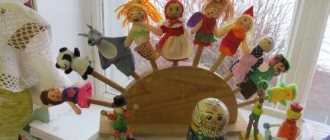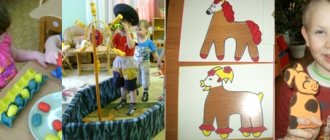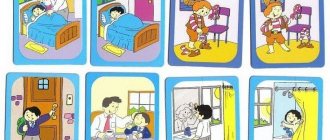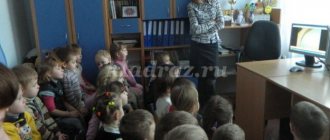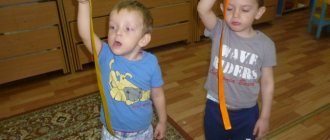Card index outdoor games for 2nd junior group
"Run to me!"
(2nd junior group)
Outdoor game with running
Target
: train children to act on a signal, run in a forward direction simultaneously as a whole group.
Attributes and equipment:-
Progress of the game
: Children stand on one side of the hall, so as not to interfere with each other. The teacher stands on the opposite side. He says: “Run to me, everyone, everyone, run to me!” The children run to the teacher, who greets them warmly, spreading his arms wide to the sides, and pretends that he wants to hug all the children. After the children gather around the teacher, he goes to the other side of the playground and again says: “Run to me!” Before the start of the game, the teacher reminds that you can run only after the words “Run to me!”, You cannot push and interfere with each other.
“ Bird and chicks”
(2nd junior group)
(1 option)
An active running game
Target:
train children to act on a signal, run and walk randomly, and use the entire area of the hall.
Attributes and equipment
:- cord.
Progress of the game:
“I will be a bird, and you will be the chicks,” says the teacher and invites the children to look at the large circle (made of cord) - this is our nest and invites the chicks into it. Children enter the circle and squat down. “The chicks flew and flew to look for grains,” says the teacher. The chicks fly out of the nest. The “mother bird” flies with the chicks throughout the hall. At the signal: “Let’s fly home to the nest!” - all the children run in a circle.
“Bird and chicks”
(2nd junior group)
(2nd option)
An active running game
Target
: train children to act on the teacher’s signal, run and walk randomly, navigate in space, use the entire area of the hall.
Attributes and equipment
:- a circle drawn with chalk, a large hoop placed on the floor or a rope tied at the ends, etc.
Progress of the game
: Children are divided into groups of 5-6 people. Each group has its own house - a nest. Children sit on their haunches, pretend to be chicks in nests, the teacher - a bird. At the signal: “The chicks have flown, the chicks have flown to look for grains,” the chicks fly out of the nest and try to fly further away for food. At the teacher’s signal: “Let’s fly home to the nest!” the chicks return to their nests.
The teacher reminds that you cannot fly into someone else’s nest, you need to fly away from home, there is more food for the birds.
“Shaggy Dog”
(2nd junior group)
Outdoor game with running
Target
: train children to act in accordance with the text of the poem, walk, run in all directions, use the entire area of the hall.
Attributes and equipment
: dog mask..
Progress of the game
: One of the children pretends to be a dog. He lies down on the floor, resting his head on his outstretched arms. The rest of the children quietly approach him in a crowd as the following text is pronounced:
Here lies a shaggy dog with his nose buried in his paws.
Quietly, quietly, he lies, either dozing or sleeping.
Let's go to him and wake him up. And we'll see if something happens.
Children begin to wake up the dog, lean towards him, say his name, clap their hands, and wave. The dog jumps up and barks loudly. The children run away. The dog chases after them, trying to catch someone. When all the children run away, the dog returns to his place.
“Birds in nests”
(2nd junior group)
Outdoor game with running
Target
: train children to act on a signal, run and walk randomly, step over a hoop, navigate in space, use the entire area of the hall.
Attributes and equipment
: large diameter hoops or circles formed from cords or ropes.
Progress of the game
: Children - “sparrows”, with the help of a teacher, are divided into 3-4 groups and stand inside “nests” (large diameter hoops or circles formed from cords or ropes). At the teacher’s signal: “Let’s fly!” - “little sparrows” fly out of the “nest”, stepping through the hoop and scatter throughout the hall. They squat down and “peck at the grains.” At the signal: “Birds, go to their nests!” - run away to their “nests”.
“Train”
(junior group 2)
Outdoor game with running
Target:
train children to walk, run in a column one at a time, changing the pace, act on a signal, find their place in the column.
Attributes and equipment
: steering wheel, driver's cap.
Progress of the game
: Children line up in a column one at a time (without holding each other). The first one is a steam locomotive, the rest are carriages. The teacher blows the whistle and the train begins to move forward, slowly at first, then faster, faster, and finally the children start running. “The train is approaching the station,” says the teacher. The children gradually slow down and the train stops. Children go out for a walk: they disperse across the clearing, picking flowers, berries, mushrooms, and pine cones. Hearing the whistle, they again gather in a column, and the movement of the train resumes. ... At first, children line up in a column in any order, and by the end of the year they get used to remembering their place in the column - finding their carriage. You can change the plot of the game, for example, the train can stop at a river, then the children pretend to be boating, fishing, etc.
"Tram (trolleybus, bus)"
(2nd junior group)
An active running game
Target:
train children to walk, run in a column of two, act in accordance with the color signal, and crawl together.
Attributes and equipment
: cord, three colored flags: yellow, red, green.
Progress of the game:
Children stand in a column in pairs, holding each other's hands. With their free hands they hold on to the cord, the ends of which are tied, that is, some children hold on to the cord with their right hand, others with their left. This is a tram. The teacher stands in one of the corners of the room, holding three colored flags in his hands: yellow, red, green. He explains that when the signal is green you have to move, when the signal is red or yellow you have to stop. The teacher raises the green flag - the tram is moving, the children are running around the room (playground). Having reached the teacher (traffic light), the children look to see if the color has changed. If the color is still green, then the tram continues to move; if a red or yellow flag is raised, the children stop and wait for the green flag to appear so that they can move again.
If there are a small number of children, you can put them in one column. You can arrange a stop along the way. Approaching it, the tram slows down and stops. To enter and exit, children lift the cord.
“Mice and Cat”
(2nd junior group)
Outdoor game with running
Target
: train children to act in accordance with the rules of the game, walk, run in all directions, use the entire area of the hall
Attributes and equipment:
toy cat, benches or chairs placed along the walls of the hall
Progress of the game
: Mice children sit in holes (on benches or chairs placed along the walls of the hall). A teacher cat sits in one of the corners of the playground. The cat falls asleep and the mice scatter around the room. But then the cat wakes up, stretches, meows and starts catching mice. The mice quickly run and hide in holes (take their places on chairs). After all the mice have returned to their holes, the cat walks around the room again, then returns to its place and falls asleep. ... Mice can run out of the holes only when the cat closes its eyes and falls asleep, and return to the holes after the cat wakes up and meows.
“Run to the flag”
(junior group 2)
Outdoor game with running
Target:
train children to act in accordance with the rules, focus on the color signal, run in all directions, and use the entire space of the hall.
Attributes and equipment
: flags of two colors: red and blue
Progress of the game:
The teacher gives the children flags of two colors: red and blue. He, holding a red flag in one hand and a blue flag in the other, spreads his arms to the sides; children are grouped on the side of the flag of the corresponding color. Then he invites the children to take a walk around the playground. While the children are walking, the teacher goes to the other side and says: “One, two, three—run here quickly!” - At the same time, he extends his hands with flags to the sides. Children run to him and gather near the flag of their color. When all the children have gathered, the teacher suggests raising the flags up and waving them. …. The teacher can move the flags from one hand to the other so that the children gather either to the right or to the left of him. Instead of flags, children can be given a handkerchief or cube of the appropriate color or tie a colored ribbon on their hand.
“Find your color”
(junior group 2)
(1 option)
An active running game
Target:
train children to act on a signal, navigate by color, walk, use the entire area of the hall.
Attributes and equipment
: hoops (5 cm), cubes (skittles) of different colors.
Progress of the game:
In three places on the site there are hoops (5 cm) with cubes (pins) of different colors in them. Children are divided into three groups, and each group takes a place around a cube of a certain color. The teacher offers to remember the color of their cube, then, at a signal, the children scatter throughout the hall. To the signal: “Find your color!” - children try to take a place near the hoop, in which there is a cube of the same color around which they initially took place.
“Find your color”
(2nd junior group)
(2nd option)
An active running game
Target:
train children to act on a signal from the teacher, navigate in space, walk, run in all directions, match colors, use the entire area of the hall, act together.
Attributes and equipment
: flags of 3-4 colors: red, blue, yellow, green.
Progress of the game
: The teacher gives the children flags of 3-4 colors: red, blue, yellow, green. Children with flags of the same color gather in different corners of the room, designated in advance by the teacher with a flag of a certain color. At the teacher’s signal “Go for a walk,” the children disperse around the playground (room) in different directions. When the teacher says: “Find your color,” the children gather near the flag of the corresponding color. The teacher notes which group gathered first.
After several repetitions, when the children have mastered the game well, the teacher can offer to stop while walking, close their eyes, and in the meantime rearrange the flags standing in the corners of the room.
“From bump to bump”
(junior group 2)
Outdoor game with jumping
Target:
to train children to act together on a signal, navigate in space, walk, run randomly,
Attributes and equipment:
hoops; instead of hoops, you can use plywood or rubber circles at a distance of 30-35 cm. On the site, circles can be drawn on the ground.
Progress of the game:
children stand on one side of the hall. The teacher places hoops on the floor at a distance of 20 cm from one another. At the signal, children move to the other side of the hall through hoops.
"On a smooth path"
(2nd junior group)
Sedentary game
Target
: train children to act in accordance with the text and rhythm of the poem, jump on two legs while moving forward, act together, use the entire area of the hall.
Attributes and equipment:
Progress of the game:
Children freely group themselves or line up in a column and go for a walk. The teacher rhythmically, at a certain pace, pronounces the following text:
Along a smooth path, along a smooth path,
Our feet are walking. One-two, one-two,
By pebbles, by pebbles, by pebbles, by pebbles... Into the hole - bang!
When the words “On a level path” are said, the children walk at a pace. When the teacher says: “By the pebbles, by the pebbles,” they jump on two legs, moving forward slightly. To the words “Into the pit - bang!” squat down. “We got out of the hole,” says the teacher, and the children rise. The game repeats itself.
“Catch a mosquito”
(junior group 2)
Outdoor game with jumping
Target:
train children to jump up from a place, reaching for an object suspended above the child’s raised hand; do not reduce the circle while jumping.
Attributes and equipment:
a rod (length 1-1.5 m) with a mosquito made of paper or cloth tied to a cord.
Progress of the game:
Children stand in a circle facing the center at arm's length. The teacher is in the middle of the circle. In his hands he holds a rod (1-1.5 m long) with a mosquito made of paper or cloth tied to a cord. The teacher circles the cord slightly above the heads of the players. When a mosquito flies overhead, children jump, trying to catch it with both hands. The one who catches the mosquito says: “I caught it!”
We must ensure that children do not shrink the circle while bouncing. Rotating the rod with the mosquito, the teacher either lowers or raises it.
“The Cat and the Sparrows”
(2nd junior group)
(1 option)
An active running game
Target:
train children to act in accordance with the text of the poem, run in a straight direction at the same time as a whole group, use the entire area of the hall.
Attributes and equipment:
cat mask
Progress of the game:
The "cat" is located on one side of the hall (area), and the children - "sparrows" - on the other. Children - “little sparrows” approach the “cat” together with the teacher, who says: Kitty, kitten, cat, Kitty - a little black tail, he is lying on a log, pretending to be asleep. To the words “As if he’s sleeping,” the “cat” exclaims: “Meow!” - and begins to catch the “sparrows” who are running away from him to their house (beyond the line).
“ The Cat and the Sparrows”
(2nd junior group)
(2nd option)
Outdoor game with jumping
Target:
train children to jump from heights.
Attributes and equipment:
bench, large cubes.
Progress of the game:
Children stand on benches, on large cubes placed on the floor at one side of the playground. These are sparrows on the roof. A cat sits to the side (the teacher or one of the children). The cat is sleeping. “The sparrows have flown,” says the teacher. The sparrows jump from the roof, spreading their wings, scattering in all directions. But then the cat wakes up. He says “meow-meow” and runs to catch the sparrows that are hiding on the roof. The cat takes the caught sparrows to his house.
Directions. Ensure that children land softly, jump off on their toes, and bend their knees.
“From bump to bump”
(junior group 2)
Outdoor game with jumping
Target:
continue to teach how to hop on two legs; jump from high objects, land softly, bending your knees; improve jumping skills.
Attributes and equipment:
Progress of the game:
children stand on one side of the hall. The teacher places hoops on the floor at a distance of 20 cm from one another. At the signal, children move to the other side of the hall through hoops.
“Hen and Chicks”
(2nd junior group)
Outdoor game with crawling
Target:
train children to act on a signal from the teacher, walk, run in all directions, crawl under an obstacle without touching the floor with their hands, use the entire area of the hall
Attributes and equipment:
(a place fenced with a rope stretched between posts or chairs at a height of 35-40 cm).
Progress of the game:
Children playing pretend to be chickens, the teacher is a hen. The chickens and the hen are kept in the house (a place fenced off with a rope stretched between posts or chairs at a height of 35-40 cm). An imaginary big bird lives off to the side. The hen crawls under the rope and goes in search of food. She calls the chickens: “Ko-ko-ko-ko.” At her call, the chickens crawl under the rope, run to the hen and walk with her, bend over, squat, and look for food. According to the teacher, “The big bird is flying!” all the chickens quickly run away and hide in the house... When the chickens return home, running away from the big bird, the teacher can raise the rope higher so that the children do not touch it.
“Mice in the pantry”
(junior group 2)
Outdoor game with crawling
Target:
train children to run in all directions, crawl under the cord, without touching the floor with their hands
Attributes and equipment:
rope, chairs and bench
Progress of the game:
Children pretend to be mice. They stand or sit on chairs and benches on one side of the site - mice in holes. On the opposite side, at a height of 50-40 cm, there is a rope stretched, behind it is a storage room. The teacher, playing the role of a cat, sits to the side of the players. The cat falls asleep. The mice run into the pantry, bend down, crawling under the rope (you must try to bend down lower so as not to touch it). In the pantry, mice squat down and gnaw on crackers. The cat wakes up, meows and runs after the mice. The mice run into their holes. (The cat does not catch mice, she only pretends that she wants to catch them). Then the cat returns to its place and falls asleep, the game continues.
“Rabbits”
(2nd junior group)
(1 option)
Outdoor game with crawling
Target:
train children to act on a signal, jump on two legs moving forward, run in all directions, crawl under the cord without touching the floor with their hands.
Attributes and equipment:
rope (cord) stretched at a height of 50 cm from the floor.
Progress of the game:
Children sit behind a rope (cord) stretched at a height of 50 cm from the floor - they are “rabbits in cages.” At the teacher’s signal: “Jump - hop to the meadow” - all the “rabbits” run out of the cages (crawl under the cord without touching the floor with their hands), jump (jump on two legs, nibble the grass. At the signal: “Watchman!” - all “ “rabbits” run back (but do not crawl under the cord, but run behind the counter).
“Rabbits”
(2nd junior group)
(2nd option)
Outdoor game with crawling
Target:
train children to act on a signal from the teacher, navigate in space, jump on two legs moving forward, run in all directions, crawl under an obstacle without touching the floor with their hands.
Attributes and equipment:
arcs.
Progress of the game:
On one side of the site there are circles (5-6) drawn with chalk - these are cages for rabbits. Arcs are placed in front of them. On the opposite side is the guard's house (the chair on which the teacher sits). Between the house and the rabbits' cages there is a meadow where the rabbits walk. The teacher divides everyone playing into groups of 3-4 children. Each group stands in one of the circles drawn on the floor. Children squat down as instructed by the teacher (rabbits sit in cages). The teacher approaches the cages one by one and releases the rabbits onto the meadow. The rabbits crawl under the arch one after another, and then run and jump on the lawn. After a while, the teacher says: “Run to the cages.” The rabbits are hurrying home. Everyone returns to their cage, crawling again under the arc. The rabbits sit in cages until the caretaker lets them out again. Instead of a crawling arc, you can use a bar placed on the racks or a stretched cord.
“Who will throw the bag next?”
(2nd junior group)
Outdoor game with throwing
Target:
train children to throw at a distance with their right and left hands, and act on a signal.
Attributes and equipment:
cord, sandbags.
Progress of the game:
Children stand on one side of the hall (area) behind a drawn line or a placed rope. Each of the players receives a bag. At the teacher’s signal, all children throw the bags into the distance. Everyone carefully watches where his bag will fall. At the next signal, the children run after the bags, pick them up and stand in the place where the bag lay. They lift the bag above their heads with both hands. The teacher marks the children who threw the bag the furthest. Children return to their original places.
It is better to play the game with half the group. You need to throw the bags according to the teacher’s instructions with both your right and left hands.
“Get in the circle”
(junior group 2)
Outdoor game with throwing
Target:
train children in throwing at a horizontal target with both hands from below.
Attributes and equipment:
hoop or circle (made of rope or drawn on the floor, diameter 1-1.5 m), bags.
Progress of the game:
Children stand in a circle at a distance of 2-3 steps from a large hoop or circle lying in the center (made of rope or drawn on the floor, diameter 1-1.5 m). The children have bags of sand in their hands. At the teacher’s signal “Drop it!” all children throw bags into a circle. Then the teacher says: “Pick up the bags.” Children pick up the bags and stand in place.
Directions. The bag must be thrown with both hands.
“Knock down the pin”
(junior group 2)
Outdoor game with throwing
Target:
train children in throwing at a horizontal target
Attributes and equipment:
plastic pins, balls or balls with a diameter of 15-20 cm.
Progress of the game:
a line is drawn on the ground. At a distance of 1-1.5 m from it, 2-3 large pins are placed (the distance between the pins is 15-20 cm). Children take turns approaching this place, picking up the lying balls, rolling them, trying to knock down the pin. After rolling 3 balls, the child runs, collects them and passes them to the next player.
“Take care of the object”
(junior group 2)
Low- movement game
Target:
train children to act on the teacher’s signal and navigate in space
Attributes and equipment:
cubes or other objects (one less than the number of players)
Progress of the game:
The players form a circle. They stand with their legs slightly apart and their hands behind their backs. At the feet of each child lies a cube (or other object). One child (leading) is in the middle of the circle. The driver tries to take a cube from one or the other child. Wanting to protect it, the player, whom the driver strives for, crouches, covers the cube with his hands and does not allow him to touch it. As soon as the driver leaves, the player gets up. A child who does not protect his cube leaves the circle. He is temporarily out of the game. When the driver manages to take a cube from 2-3 players, a new driver is called. When the driver changes, the children standing behind the circle return to the circle and the game is repeated.
Rules. Close the cube only when the driver approaches it. As soon as the driver leaves, get up immediately.
“Find your place”
(junior group 2)
An outdoor game with running
for orientation in space
Purpose:
train children to act on the teacher’s signal and navigate in space.
Attributes and equipment:
handkerchief
Progress of the game:
Children form a circle. The driver behind the circle with a handkerchief in his hand. At the teacher’s signal, he runs after the children standing in a circle, puts a scarf on one of them’s shoulders and continues to run. The one who has the scarf runs towards the driver. At this time, the children move apart, as if filling the vacant space. The driver and the child with the scarf must find this place and stand up.
Rules: the one who gets to his place remains in the circle, and the one who is late stands next to him.
"Guess who is screaming and where"
(2nd junior group)
Slightly active game
for orientation in space
Purpose:
Develop attention in children.
Attributes and equipment:
bell
Progress of the game:
Children sit facing the wall. The teacher's assistant hides at the other end of the room and rings the bell. The teacher says: “Listen to where it rings and find the bell.” When the children find the bell, the teacher praises them, and then again invites them to return to the wall. The teacher's assistant rings the bell again, hiding in another place.
“Find what’s hidden”
(junior group 2)
Low- movement game
for orientation in space
Purpose:
Develop children's visual memory and attention.
Attributes and equipment:
three to five items
Progress of the game:
Children sit on chairs, on the floor, in one line. The teacher places three to five objects in the center of the circle and asks them to remember them. Then the players stand up and turn their backs to the center or to the wall and close their eyes. The teacher hides one object lying in the center of the circle and says “Look.” Children open their eyes, turn to face the cent and remember which object is missing. The teacher approaches the children and each of them tells him in his ear what is hidden. When the majority of players give the correct answer, the teacher loudly names the hidden object. After this, the game resumes.
Rules:
1. When the teacher hides the object, the players turn their backs and close their eyes
2. At the signal “Look!”, the players open their eyes and again turn to face the center of the circle.
Options: Consolidate knowledge of primary colors, take cubes or flags. Call one player. Remove 2 items at a time.
Techniques
The organization of gaming activities is based on three groups of techniques.
Verbal
In working with children 3–4 years old, who, based on age-related developmental characteristics, are actively mastering speech and replenishing active and passive vocabulary, the teacher’s word plays a leading role. An adult is perceived not only as giving instructions, but also as a kind of language model, which children are guided by in organizing their own acts of speech. When preparing outdoor games, the teacher uses three types of verbal techniques.
- Explanation. In order for the children to accurately follow the rules of the game and know the set of actions, the teacher describes each stage in detail, indicating all the movements of each participant.
The teacher must comment on every action in the game
- Puzzles. This technique perfectly motivates little pupils to play and prepares them to complete tasks. Considering the age of the children, it is better to select riddles with rhyming agreements. Thus, the beginning of the game “Sparrows and the Car” can be preceded by the following riddle: A cry is heard under the eaves: “Chick-chirp and chick-chirp!” The gray one teaches these songs to children... (Sparrow).
- Short verbal sketches. Usually, to present the plot of the game, the teacher himself composes small tales. For example, the fun “Hen and Chicks” can begin with a short sketch. Once upon a time there lived a Hen and she had many chickens. Often they did not listen to their mother and ran out from under her wing. One day, when the kids ran away, Big Bird flew in and chased the chicks. The chickens were scared, but managed to hide under the wings of their mother hen. From now on, the kids are very attentive and do not run far.
Visual
The visual channel of perception in children is the main one, therefore, to fully understand the conditions of the game, children need to see:
- pictures (depicting game heroes and/or children fulfilling the conditions of the fun);
- a sample of actions (an adult must participate in any games, initially demonstrating the movements of all participants).
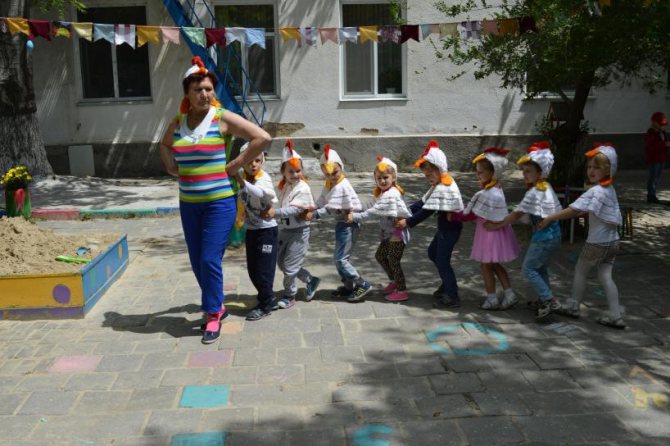
The demonstration helps children make sure that the adult is a participant in the game just like them.
Practical
This is actually the game situation itself, in which children and the teacher are involved. Moreover, to develop initiative, after 2-3 repetitions, the teacher gives more and more game functions to the children: if, when familiarizing themselves with the rules, the teacher is the driver, then the child then takes on this role.
